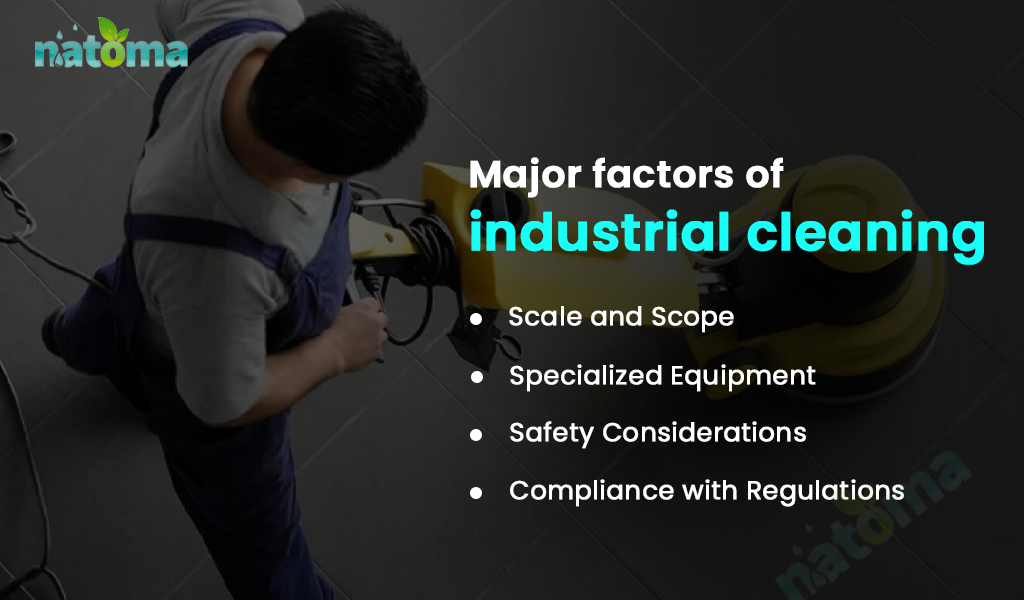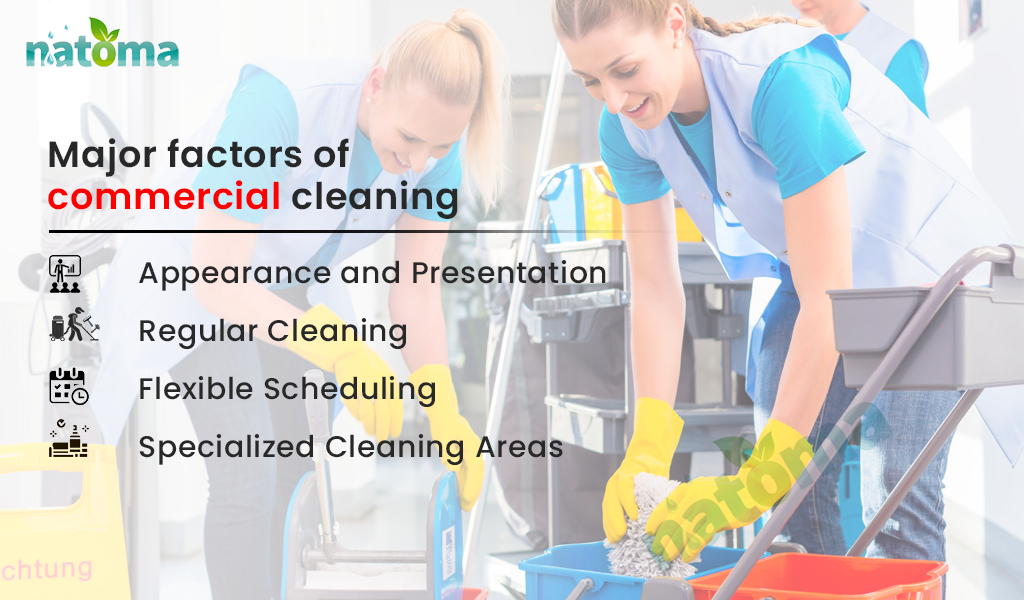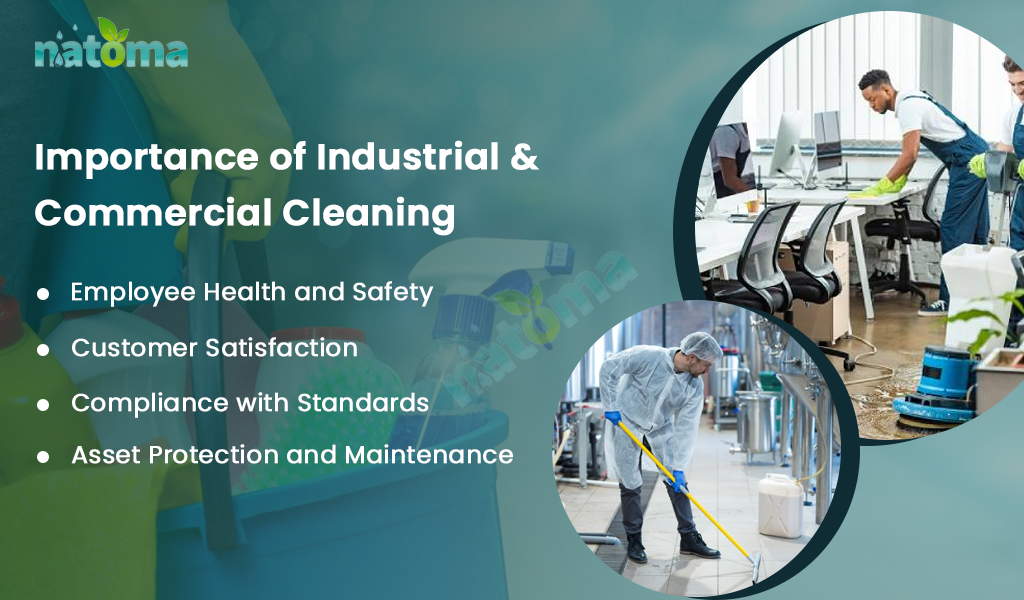Maintaining cleanliness and hygiene in Singapore in both industrial and commercial settings is crucial for employees, customers, and the business’s overall success. However, industrial and commercial cleaning are two distinct approaches tailored to each environment’s specific requirements and challenges.

This blog explores the differences between commercial and industrial cleaning, highlighting their unique characteristics, importance, and the specialized cleaning practices involved in each.
What is Industrial Cleaning?
Industrial cleaning focuses on large-scale facilities, such as factories, manufacturing plants, warehouses, and power plants. These environments often involve heavy machinery, production lines, and specialized equipment.
Major factors of industrial cleaning
Here are some critical aspects of industrial cleaning:

Scale and Scope
Industrial facilities are characterized by their vast size and complex layouts. They require comprehensive cleaning methods that cover extensive floor areas, high ceilings, hard-to-reach corners, and various surfaces.
Specialized Equipment
Industrial cleaning necessitates using heavy-duty equipment, including industrial-grade vacuum cleaners, power washers, steam cleaners, and scrubbing machines. These tools are designed to tackle tough stains, grime, oil, and chemical residues commonly found in industrial environments.
Safety Considerations
Industrial cleaning in Singapore poses unique safety risks due to hazardous materials, machinery, and potential exposure to harmful substances. Natoma Cleaning professionals in industrial settings are well-trained in safety protocols, handling chemicals, and using personal protective equipment (PPE) to ensure their well-being and the environment.
Compliance with Regulations
Industrial facilities are subject to various regulations and standards related to cleanliness, health, and safety. Adhering to these regulations is essential to maintain a safe working environment and avoid penalties or legal consequences.
Examples of Industrial Cleaning Settings and Tasks
Here are some examples of settings and the tasks typically involved in industrial cleaning solutions:
Manufacturing Plants
- Cleaning production floors to remove dust, debris, and residues.
- Deep cleaning and degreasing machinery and equipment.
- Clearing and unclogging industrial ventilation systems.
- Cleaning and sanitizing restrooms and break areas.
- Removing hazardous waste and disposing of it safely.
Warehouses
- Sweeping and mopping large warehouse floors.
- High-pressure washing of loading docks and exterior areas.
- Cleaning and organizing storage racks and shelves.
- Dusting and wiping down surfaces and equipment.
- Clearing and maintaining fire exits and emergency pathways.
Power Plants
- Cleaning and maintaining power generation equipment.
- Dusting and cleaning control rooms and monitoring stations.
- Cleaning and degreasing electrical panels and wiring.
- Removing soot and ash from boilers and chimneys.
- Deep cleaning cooling towers and condenser units.
Food Processing Facilities
- Thoroughly cleaning and sanitizing food preparation areas.
- Cleaning and disinfecting processing equipment and conveyor belts.
- Washing and sanitizing storage tanks and vats.
- Removing grease and grime from kitchen exhaust systems.
- Performing regular pest control measures.
Oil Refineries
- Cleaning and degreasing pipelines, valves, and tanks.
- Removing oil spills and residues from floors and surfaces.
- High-pressure washing of refinery equipment.
- Cleaning and maintaining control rooms and instrumentation.
- Handling and disposing of hazardous materials according to regulations.
Automotive Workshops
- Cleaning and degreasing vehicle repair bays.
- Removing oil, grease, and other automotive fluids from floors.
- Cleaning and maintaining car lifts and hydraulic equipment.
- Detailing and cleaning vehicle interiors and exteriors.
- Recycling and disposing of used automotive products safely.
What is Commercial Cleaning?
Commercial cleaning refers to the professional cleaning services provided to various commercial establishments such as offices, retail stores, restaurants, hotels, healthcare facilities, and more. It involves the systematic and thorough cleaning of these commercial spaces to maintain cleanliness, hygiene, and a pleasant environment for employees, customers, and visitors.
Major factors of commercial cleaning
Here are the critical aspects of commercial cleaning:

Appearance and Presentation
Commercial spaces prioritize cleanliness to create a positive impression on customers and provide employees with a comfortable and healthy environment. Dust-free surfaces, spotless windows, polished floors, and sanitized restrooms contribute to a pleasant atmosphere.
Regular Cleaning
Commercial cleaning typically involves regular, ongoing cleaning services, often performed outside business hours. Natoma cleaning professionals in Singapore work discreetly and efficiently to minimize disruptions to daily operations.
Flexible Scheduling
Commercial cleaning services are tailored to each business’s unique requirements and schedules. Cleaning tasks are planned to fit within specific timeframes, ensuring minimal interference with customers and employees.
Specialized Cleaning Areas
Different commercial establishments have specific cleaning needs. For instance, restaurants require kitchen deep cleaning and sanitization to comply with food safety standards, while healthcare facilities need specialized disinfection protocols to maintain high hygiene levels.
Examples of commercial cleaning settings and tasks
Here are some examples of commercial cleaning settings and tasks:
- Vacuuming, mopping, and sweeping office floors.
- Dusting and wiping down desks, tables, and chairs.
- Cleaning and disinfecting shared spaces, such as conference rooms and break areas.
- Emptying and sanitizing trash bins.
- Cleaning and polishing glass surfaces, windows, and mirrors.
- Restocking restroom supplies and cleaning restroom facilities.
Learn More – Office Cleaning Doesn’t Have To Be Hard, Read These 9 Tips
Retail Store
- Sweeping and mopping sales floors.
- Cleaning and disinfecting checkout counters and cash registers.
- Dusting and organizing shelves and displays.
- Cleaning and maintaining dressing rooms.
- Spot cleaning windows and glass doors.
- Removing litter and trash from the premises.
Restaurants
- Thoroughly cleaning and sanitizing kitchen areas, including food preparation surfaces, stoves, and ovens.
- Washing and disinfecting kitchen utensils, cookware, and equipment.
- Cleaning and sanitizing dining areas, tables, and chairs.
- Sweeping and mopping restaurant floors.
- Clearing and sanitizing food storage areas.
- Cleaning and restocking restrooms.
Hotels
- Cleaning and changing bed linens and towels.
- Vacuuming and mopping hotel rooms and hallways.
- Dusting and wiping down furniture, fixtures, and appliances.
- Cleaning and disinfecting bathrooms.
- Replenishing toiletries and supplies.
- Cleaning and maintaining common areas, such as lobbies, elevators, and fitness centers.
Healthcare Facilities
- Performing thorough disinfection and sanitization procedures.
- Cleaning and sterilizing medical equipment and instruments.
- Emptying and sanitizing medical waste containers.
- Cleaning and disinfecting patient rooms and examination areas.
- Sweeping and mopping hallways and waiting areas.
- Maintaining high hygiene standards in restrooms and common areas.
Equipment used in industrial vs. commercial cleaning
Industrial Cleaning Equipment
Industrial Vacuum Cleaners
Industrial-grade vacuum cleaners are specifically designed to handle the demanding cleaning needs of large industrial spaces. These powerful machines effectively remove heavy debris, dust, and dirt commonly found in industrial environments.
High-pressure Washers
Industrial settings often require thorough and robust cleaning, which is where high-pressure washers come in. These machines utilize strong water jets to clean and remove tough stains, grime, and contaminants from large surfaces, machinery, and equipment.
Scrubbing Machines
Industrial scrubbers are essential for deep cleaning and maintenance of industrial floors. They come in various sizes and types, such as ride-on or walk-behind scrubbers. Equipped with rotating brushes or pads, these machines efficiently scrub and remove dirt from different floor surfaces.
Steam Cleaners
Steam cleaners are highly effective in industrial cleaning as they use high-temperature steam to sanitize and disinfect surfaces. They are particularly useful in removing grease, oil, and stubborn stains from industrial equipment, machinery, and floors.
Power Sweepers
To tackle outdoor cleaning tasks in industrial settings, power sweepers are employed. These machines are equipped with rotating brushes and advanced debris collection systems, making them efficient for sweeping large areas such as parking lots and loading docks.
Chemical Applicators
Industrial cleaning often involves using specialized chemicals for tasks like degreasing, disinfection, and stain removal. Chemical applicators, such as sprayers and foamers, are employed to apply these cleaning agents effectively and efficiently.
Commercial Cleaning Equipment
Upright or Canister Vacuum Cleaners
In commercial settings, upright or canister vacuum cleaners are commonly used due to their compact size and versatility. These vacuum cleaners are suitable for cleaning various surfaces, including carpets, hard floors, and upholstery.
Floor Buffers and Polishers
Commercial floor maintenance often requires the use of floor buffers and polishers. These machines employ rotating pads or brushes to remove scuffs, restore shine, and maintain the appearance of hard floors such as vinyl, hardwood, or tile.
Carpet Extractors
Commercial spaces with carpets utilize carpet extractors for deep cleaning. These specialized machines spray water and cleaning solutions onto the carpet, effectively loosening dirt and stains. They then extract the key along with the loosened dirt, leaving carpets fresh and clean.
Window Cleaning Equipment
Window cleaning in commercial settings often involves using tools like squeegees, extension poles, and window scrapers. These tools help achieve streak-free and spotless windows, ensuring a clean and appealing environment.
Microfiber Cleaning Tools
Microfiber mops, cloths, and dusters are widely used in commercial cleaning due to their superior absorbency and effectiveness in capturing dirt and dust. These tools are gentle on surfaces and provide efficient cleaning.
Auto Scrubbers
Auto scrubbers are specifically designed to clean large areas, such as retail floors, efficiently. These machines combine scrubbing, cleaning, and drying functions in one pass, making them time-saving and highly effective for commercial cleaning tasks.
Importance of Industrial and Commercial Cleaning
Both industrial and commercial cleaning are crucial in ensuring cleanliness, safety, and productivity in their respective environments. Here are some reasons highlighting their importance:

Employee Health and Safety
Clean environments promote employee health, reduce the risk of accidents, and contribute to a more productive workforce. Regular cleaning, removal of allergens, and proper waste management help create a safe and healthy workplace.
Customer Satisfaction
In commercial settings, clean and well-maintained spaces enhance the customer experience. A tidy appearance, fresh-smelling environment, and sanitary facilities leave a positive impression on visitors, encouraging repeat business and positive reviews.
Compliance with Standards
Industrial and commercial facilities must adhere to various industry-specific standards and regulations. Regular cleaning ensures compliance with health and safety guidelines, preventing fines, closures, or damage to the brand’s reputation.
Asset Protection and Maintenance
Regular cleaning and maintenance of industrial equipment and commercial facilities help extend their lifespan and prevent costly repairs or replacements. Removing dust, grime, and contaminants from machinery and surfaces enhances efficiency and functionality.
Conclusion
While industrial and commercial cleaning share the common goal of maintaining cleanliness, they differ significantly in scale, scope, equipment, and specialized practices. Understanding these distinctions is essential for businesses to choose the right cleaning services that meet their specific needs.
By investing in industrial and commercial cleaning, organizations prioritize the well-being of their employees, create a positive customer experience, and ensure compliance with regulations, ultimately contributing to their success.


No Comments